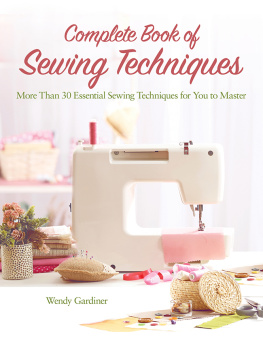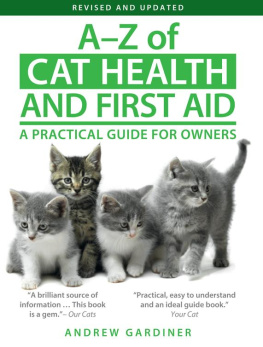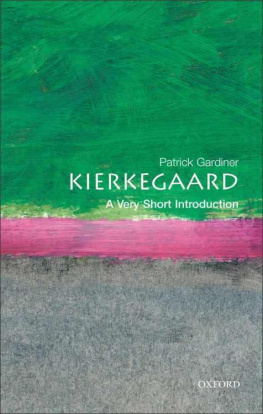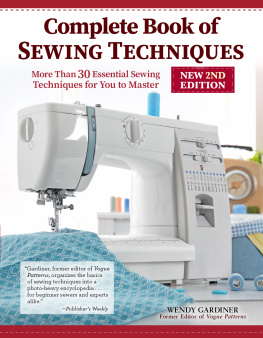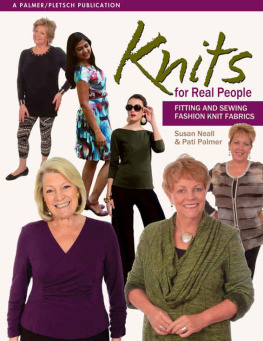
COMPLETE BOOK OF SEWING TECHNIQUES
CompanionHouse Books is an imprint of Fox Chapel Publishers International Ltd.
Project Team
Editorial Director: Christopher Reggio
Editor: Colleen Dorsey
Copy Editor: Laura Taylor
Art Director: Mary Ann Kahn
Designer: Wendy Reynolds
Index: Jay Kreider
Copyright 2017 by IMM Lifestyle Books.
All rights reserved. No part of this book may be reproduced, stored in a retrieval system, or transmitted in any form or by any means, electronic, mechanical, photocopying, recording, or otherwise, without the prior written permission of Fox Chapel Publishers, except for the inclusion of brief quotations in an acknowledged review.
Print ISBN 978-1-62008-236-2
Library of Congress Cataloging-in-Publication Data
Names: Gardiner, Wendy, author.
Title: Complete book of sewing techniques / Wendy Gardiner.
Description: Mount Joy : CompanionHouse Books, 2017. | Includes
bibliographical references and index.
Identifiers: LCCN 2017028427 | ISBN 9781620082362 (pbk. : alk. paper)
Subjects: LCSH: Sewing.
Classification: LCC TT705 .G37 2017 | DDC 646.2dc23
LC record available at https://lccn.loc.gov/2017028427
This book has been published with the intent to provide accurate and authoritative information in regard to the subject matter within. While every precaution has been taken in the preparation of this book, the author and publisher expressly disclaim any responsibility for any errors, omissions, or adverse effects arising from the use or application of the information contained herein.
Fox Chapel Publishing, 903 Square Street, Mount Joy, PA 17552
Fox Chapel Publishers International Ltd., 7 Danefield Road, Selsey (Chichester), West Sussex PO20 9DA, U.K.
www.facebook.com/companionhousebooks

Sewing Essentials

Sewing Machines
There is a huge range of sewing machines available today, ranging from basic models that do straight and zigzag stitch, to computerized embroidery machines that can stitch beautiful embroidery designs that you have customized yourself.
A sewing machine helps you to stitch faster, creating neat, even stitching time after time. Using the correct feet also helps with different types of sewing, whether it is inserting a zipper or creating perfectly formed buttonholes every time. Using different stitches that are built into the sewing machine enables you to embellish and customize by adding decorative stitching, trims, and fringe.
HOW THEY WORK
Electronic models stitch automatically when pressure is applied to the foot pedal the heavier the pressure, the faster the machine stitches. Stitch choice, length, and width are chosen by changing the direction of dials or buttons, usually located on the front of the machine. They might also have a small LCD screen to show selections made.
Computerized models are fully automated they automatically set the correct stitch tension, length, and width for the stitch you have chosen on the LCD touch screen. The screen also displays the recommended foot, and the option to change the stitch length or width, etc., to suit your own preferences. For instance, you may select a straight stitch, but want to increase the stitch length to maximum in order to make a gathering stitch. The automatic tension means that you can sew a single layer of flimsy fabric as evenly as multi-layers of denim or fleece. Computerized models also have a variety of embroidery designs and alphabets built in.
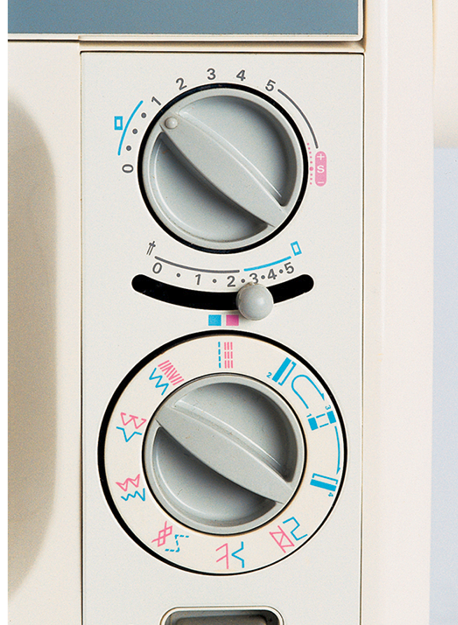
Stitch dials
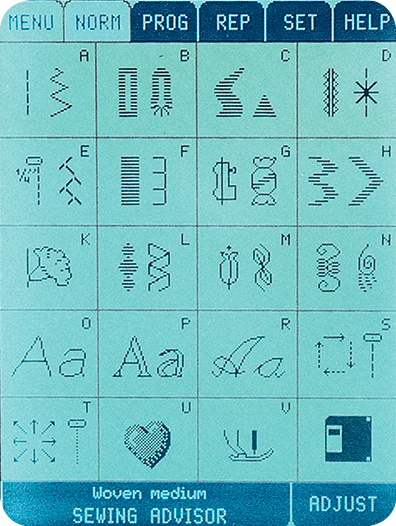
An LCD display
CHOOSING A NEW SEWING MACHINE
Which type of sewing machine you buy will depend on budget, type of sewing, and personal preference. However, always buy the best you can afford, even if it has more features than you need at the moment you can grow in to them. The following are a few basic guidelines to consider when choosing a new machine:
Try out different models in your budget range to see how they sew different weights and types of fabric. Take your own fabric samples to try.
Check the ease of threading both top thread and bobbin. Can the bobbin be wound with thread without unthreading the top thread and needle? Useful if a new bobbin is needed in the middle of a seam! Drop-in bobbins are less awkward than front-loading (or rotary hook) bobbins.
Most modern machines have snap-on feet, which makes changing feet for different sewing techniques much easier. Check what feet are included in the basic price and what optional extras are available. Essentials are straight stitch, buttonhole, zipper, blind-hem, darning/free motion, appliqu.
Look for a variable stitch speed which allows you to control how fast or slow you stitch. This is very important when stitching around tricky curves and corners or applying appliqu.
If you intend to sew soft furnishings and other large projects, check the size of the throat space between the body of the machine and the needle. Bigger is better in order to fit large quantities of fabric through. Equally, a wide flatbed surface helps guide fabric. Some machines have an optional extension table.
If you intend to carry your machine to workshops, check the weight and portability. What type of cover does it have? Note that computerized machines are much heavier than electronic machines.
Ask about warranty, servicing, and repair facilities. Many manufacturers offer a 3- to 5-year warranty.
Ask about courses, workshops, and after-sales service. Many manufacturers offer tutorials as part of the purchase price.
How easy will it be to update a computerized model? Technology continues to advance, bringing new developments and stitch choices can your preferred model be updated?
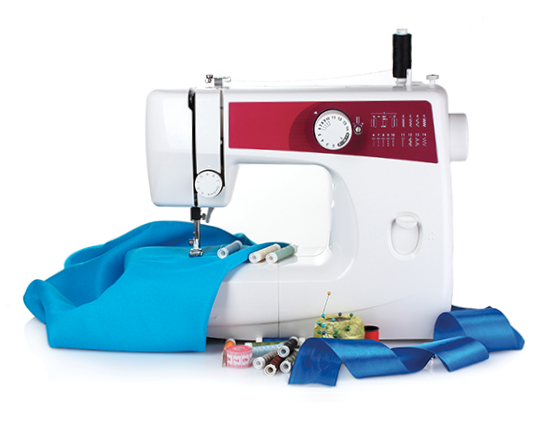
THREADING
Each sewing machine looks slightly different depending on the model and manufacturer. However, the main principles are the same on all. Check your users manual to determine where the relevant features are on your model.
Upper thread
Most machines have one or two upper-thread pins on which the thread spool is placed; these may be vertical or horizontal. Which way round to place the spool (with thread coming over the top or from under the spool) is important because it can affect the way the machine stitches, so check your users manual. Once the thread is on the pin, add a spool holder to keep the spool from bouncing up and down the pin when it revolves (which will cause uneven stitching or broken threads). The thread is then taken from the spool, through a thread guide on the top of the machine, down, then up through tension disks before being fed behind a hook on the needle column and then threaded from the front to the back of the needle (diagram 1).

Next page
